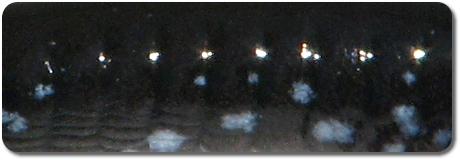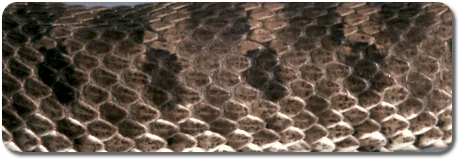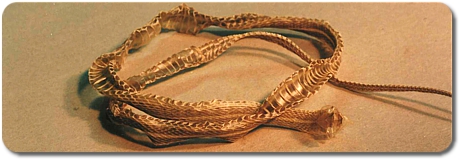The Skin of Amphibians and Reptiles
AMPHIBIAN SKIN
Slimy Skin?
Some amphibians have slimy skin, but some don't. Most amphibians have soft, smooth skin and they keep their skin wet. Their skin feels slimy, but it's really just slippery from being wet. Toads have thicker skin that feels soft, but dry. Mudpuppies, a kind of salamander, have very slimy skin just like a fish. They live in the water and their thick slime helps protect their skin.
Airy Skin
Amphibians can breathe through their skin! They have lungs to breathe air in and out, but air moves in and out of their skin, too. They also drink through their skin. They sit in a wet place and water moves into their body through their skin.

The smooth, soft skin of a Blue-spotted Salamander.
Shed Skin
Amphibians shed the outer layer of their skin several times a year. The shed skin is soft and they eat it. You won't find the skin of a frog or salamander, like you could find the skin of a snake.
Safe Skin
Some amphibians are protected by their skin. Some toads and salamanders have bad tasting liquids in their skin. If an animal tries to eat them it gets a mouthful of the bad tasting liquid, lets go and the amphibian gets away.
Colourful Skin
Each kind of amphibian has its own colours and patterns on its skin. Most of Manitoba's amphibians are coloured to blend into the kind of habitat where they live. Some can change their colours to match different surroundings and most can make themselves lighter or darker to better match their surroundings.

REPTILE SKIN
Slimy Skin?
No! Reptiles are not slimy. They have dry skin that can be soft or hard and scaly.

The smooth, scaly skin of a Western Hognose Snake.
Airy Skin
Turtles spend winter on the bottom of ponds, lakes and rivers. Under the ice there is no air to breath, but they can get oxygen from the water through their skin.
Shed Skin
All reptiles shed the outer layer of their old skin and grow new skin. Snakes shed their skin all at once and it comes off like an old sock. Lizards and turtles shed their skin in bits and pieces. Turtles even shed the scales on their shells. Reptiles don't eat their shed skin.

A shed skin of a Red-sided Garter Snake.
Safe Skin
Reptile skin is leathery or scaly to help them keep water in their bodies. Tough, scaly skin protects them from predators. Turtles bony shells are covered in scales, which are part of the skin, too.
Colourful Skin
Each kind of reptile has its own colours and patterns of skin. Most are coloured to blend into the kind of habitat where they live. Some can change colour on parts of their bodies, but most can't change their colours like amphibians can.

Next: What Do They Eat?
Or back to: About Amphibians and Reptiles or the Front Page
